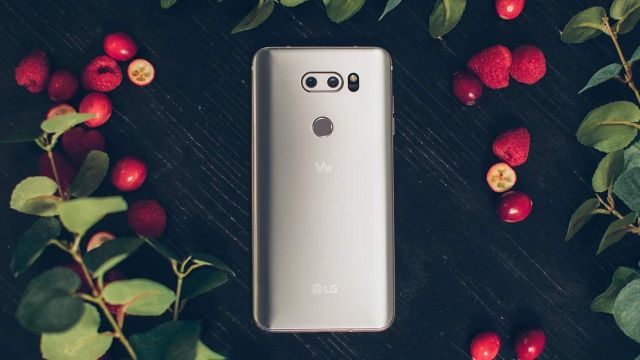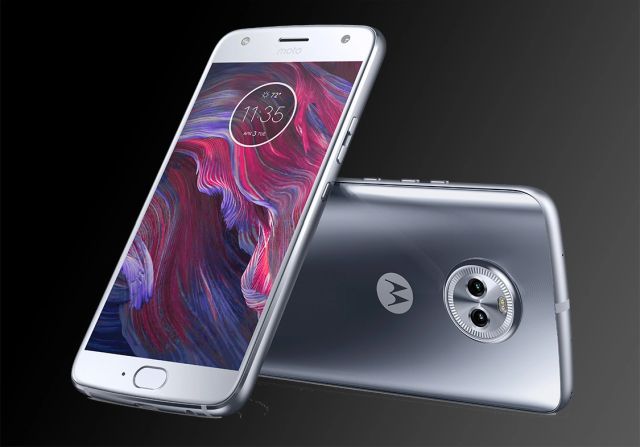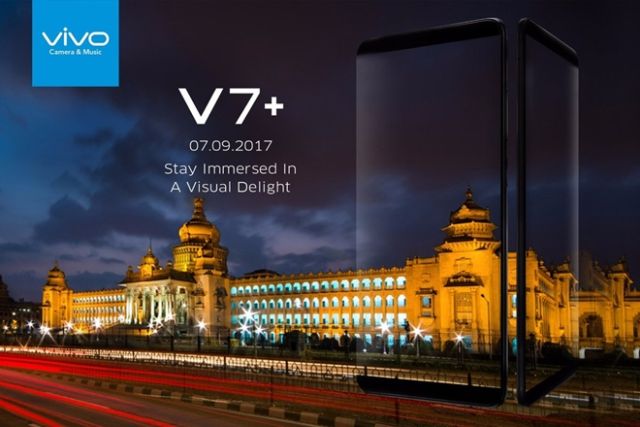
by admin | May 25, 2021 | Branding, Business, Large Enterprise, Markets, Online Marketing, Technology
 By Krishna SinhaChaudhury,
By Krishna SinhaChaudhury,
New Delhi : LG has been a dark horse in the flagship smartphone race, in a market that is dominated by the likes of Samsung, Apple and Google — not to forget Chinese smartphone players like OnePlus and Honor.
Just like Samsung, LG has been following the system of launching two flagships in a year: It launched its G6 early last year and the second one — the V30+ (4GB RAM and 128GB onboard storage) for Rs 44,990 — came in the fag end of 2017.
At first glance, the V30+ looks like a dependable device but is there more to it? Let’s find out.
Talking about the display, LG’s “FullVision” 6-inch QHD+ display with 18:9 aspect ratio and a resolution of 2880×1440 pixels takes up most of the space.
There are thin, understated bezels at the ends and the sides of the phone that lets the screen take centre-stage. However, the display with distinctly-rounded corners looks a lot like Google Pixel 2 XL.
In fact, the screen is the common factor between both the devices — that is the QHD+ P-OLED screen developed by LG.
The V30+, however, served up a brighter and slightly punchier screen than Google Pixel 2 XL. Having said that, there are options for tweaking the colour tones.
The rear of the device sees a liberal use of glass with the dual-camera system (16MP+13MP sensor) sitting beside the flash — in typical LG style. The fingerprint scanner has been embedded into the power button that lies below the camera module.
The device features a camera with a standard and a wide-angle lens. This especially makes the camera useful for capturing landscape photos without having to step far back.
The rear camera is pretty competent and pictures came out with clean colours and enough detail.
The camera bump is not big enough to make the phone wobbly when placed on flat surfaces.
The device’s light form factor was pretty impressive for a flagship phone. An added advantage is IP68 certification for water and dust resistance.
The onboard storage is just enough for storing memories. The internal memory can be expanded up to 2TB using a MicroSD card but that will take up the space of a second SIM as the device has a hybrid dual-SIM design.
A 3,300mAh battery fuels the phone which is supported by wireless charging as well as QuickCharge 3.0 technology.
We found the battery back-up very impressive as it lasted more than a day on rigorous use.
The single bottom-firing speaker on the V30+ was loud enough to not let us miss calls.
The responsiveness and performance was good thanks to the Qualcomm Snapdragon 835 chipset.
The device also did not get heated up when used for multi-tasking or continuous usage.
What does not work?
The notorious blue tint associated with P-OLED screens, which we also wrote about while reviewing the Google Pixel 2 XL, was also visible here — which is annoying.
The camera app in V30+ comes loaded with modes such as “snap shot”, “match shot”, “guide shot”, “grid shot” among others which we thought were not of much practical use.
The picture quality is not at par with the ones shot on other flagship devices such as Samsung Galaxy Note 8 or the Pixel 2 XL. A shortcut bar in the camera app lets you add photos to social media posts directly which is also not of much use.
The 5MP wide-angle front shooter is a let-down, especially for selfie addicts.
Conclusion: It is good to see LG take a big leap when it comes to the design language and overall performance. The phone has a few caveats like the screen tint issue and a slightly underwhelming camera. But given the price point, the V30+ makes for a great overall package.
(Krishna SinhaChaudhury can be contacted at krishna.s@ians.in)
—IANS

by admin | May 25, 2021 | Branding, Business, Emerging Businesses, Large Enterprise, Markets, Technology

InFocus Vision 3
By Vivek Singh Chauhan,
New Delhi : In a bid to offer a pocket-friendly smartphone with good features, US-based technology company InFocus Mobile has launched a new device — Vision 3 — in India with bezel-less (edge-to-edge) display in the sub-Rs 7,000 category.
At Rs 6,999, Vision 3 offers a camera feature called “Dualfie” for photography enthusiasts.
Let’s see what works for this affordable device.
One high point is its 5.7-inch “full-vision’ HD+ display with an aspect ratio of 18:9 for a better and immersive viewing experience.
Most smartphones in the past featured displays with a 16:9 aspect ratio — a standard ratio for TVs and cinema theatre screens. However, several smartphone makers moved to an 18:9 ratio this year and InFocus has now tried this.
The display was bright and readability under direct sunlight was good. The bezels surrounding the display are thin that makes the smartphone look impressive.
Though the device bears a hefty look, it is light-weight and comfortable to use.
Vision 3 sports a dual camera set-up with 13MP auto-zooming (AZ) lens and 5MP 120-degree wide-angle lens at the rear. The camera app is handy and comes pre-loaded with features such as “beauty” mode, “panorama” and “pro”.
The 8MP front shooter delivered decent images in both proper and low-light conditions. Both the rear and front cameras worked fine and clicked decent images during daylight conditions with enough details.
Given the budget pricing, the camera quality of Vision 3 is the best when compared to previous devices launched by the company.
The “Dualfie” camera feature that we first saw in the premium Nokia 8 smartphone allowed us to capture images from the front and rear camera simultaneously and view it on the screen. The company has named the feature “PIP” in the camera app.
On the battery front, the device sports a 4,000mAh battery which is applaudable. It lasted more than a day on a single charge with rigorous usage that included gaming and 4G connectivity.
The device also has a fingerprint sensor on the back that works fine.
Powered by 1.3GHz MTK 6737H processor paired with 2GB RAM and 16GB internal storage which can be expanded up to 64GB via a hybrid MicroSD card slot.
The phone runs the company’s custom Smile UX User Interface UI) based on Android 7.0 Nougat Operating System (OS).
What does not work?
A single speaker at the rear is a bit dated when compared with other Android smartphones in this price segment.
Also, the 2GB RAM seemed to be insufficient as we noticed significant lag while playing heavy games on the device. However, this is expected from a low-budget smartphone that tries to balance out the features with the pricing.
Conclusion: The display and camera of the phone are good enough to make you ignore the few misses. The device offers a decent camera with smooth performance in the sub-Rs 7,000 price segment.
(Vivek Singh Chauhan can be contacted at vivek.c@ians.in)
—IANS

by admin | May 25, 2021 | Branding, Business, Marketing Basics, Markets, Medium Enterprise, Technology

Moto X4
By Sourabh Kulesh,
New Delhi : Aligning with its India strategy to tap the consumer mindset rather than focusing on market share, Lenovo-owned Motorola has just launched mid-price segment device Moto X4.
The Rs 22,999 (4GB RAM+64GB storage) Moto X4 claims to deliver best-in-class experience when compared with other devices like Vivo V7+ and OPPO F3 Plus in the same price range.
Will Moto X4 rule the mid-range smartphones? Let’s find out.
The basic design is similar to Moto G5 Plus, with a 5.2-inch Full-HD display, thick bezels on the top and bottom on front and a dual-camera set-up at the back — all housed in a unibody metal and glass body.
The device has a regular oval fingerprint sensor below the display that doubles up as navigation keys.
The primary dual-camera (12MP+8MP) is neatly placed in a ring at the back with a dual-tone LED flash. The 12MP sensor has dual-autofocus pixel sensor (f2.0, 1.4um) while 8MP camera has ultra-wide angle with 120-degrees field of view sensor (f2.2, 1.12um).
Photos in the daylight conditions were rich in colours. In low-light conditions, we got the desired pictures by manually clicking with the “professional mode” feature.
The camera has other features like “ultra-wide angle shot” and “depth detection effects”.
The 16MP front shooter is complemented by a selfie flash which gives an option to click clearer images even in low-light conditions. You can also capture group photos with the selfie panorama feature.
On the hardware front, Moto X4 is powered by the Qualcomm Snapdragon 630 processor and has 64GB on-board storage that can be expanded up to 2TB.
The IP68-rated (water resistant) device functioned smoothly with multiple apps running in the background. We did not experience any lags or heating issues while using the device for regular functions.
The device runs Android 7.1 Nougat OS that offers near stock Android experience — one of the best points of the Moto brand.
Moto X4 also has several gesture modes like the chop gesture that turns on the flashlight.
The navigation keys can be removed from the display and you can navigate by swiping left on the fingerprint scanner to go to the previous screen and swipe right for “recent” tabs, thus giving more screen space to the users.
Moto X4 has 3,000mAh battery that lasted for more than a day on a single charge for normal use. The usage included multimedia consumption for nearly 10 hours with the handset being always connected to Internet.
It has got fast-charging technology that charges the device in less than an hour.
What doesn’t work?
The camera bump is a put off which makes the phone wobbly. The glass finish will have fingerprint smudges and so you will need a back cover.
Hard-core gaming (Asphalt Xtreme) did not deliver a smooth experience. It stuttered and heated during the test.
Conclusion: Moto X4 has looks, hardware and software that make it a good choice for millennials who are looking for a power-packed mid-segment device. Motorola also has a 3GB RAM + 32GB ROM variant for Rs 20,999 which can also be looked at.
(Sourabh Kulesh can be contacted at sourabh.k@ians.in)
—IANS

by admin | May 25, 2021 | Branding, Business, Emerging Businesses, Marketing Basics, Markets, Medium Enterprise, SMEs, Technology

Vivo V7
By Sourabh Kulesh,
New Delhi : When it comes to the selfie-focused smartphones market in India, Chinese smartphone players Vivo and Oppo clearly rule the mid-price segment.
Expanding its selfie-focused series, Vivo has announced two devices — V7 and V7+ — with the latter being made available in November.
Launched now, the Rs 18,990 V7 is the scaled-down version of V7+ — the Rs 21,990 device that lured the selfie-loving generation in India with a 24MP front camera (f/2.0 aperture) and bezel-less display.
V7 has the same camera as V7+ but has a bit less battery capacity, on-board memory and display size.
Vivo V7 directly rivals the Rs 19,990 Oppo F5 which has a 20MP selfie shooter.
Let us see if Vivo V7 can become a mid-segment selfie winner.
Design-wise, the trimmed antenna lines running on the upper and lower edges at the back are a differentiating factor, giving a premium look to the device.
Encased in metal-finished plastic body on the back and 2.5D glass on the front, the device is light and fits well in the hand.
The key highlight of V7+ was its edge-to-edge 5.99-inch IPS “Full View” display that is similar to Samsung’s “Infinity Display” and LG’s “FullVision Display”.
The V7 display has similar 18:9 aspect ratio as the V7+. It has very thin bezels on the side and enough space on the top for the 24MP front camera and sensors.
The 24MP front shooter has a selfie portrait mode and supports HDR.
The “live photo” feature creates a moving image, instead of capturing a moment in time with a still photo.
Users can use voice command or hand gesture to trigger the camera. Selfies had nice details under good lighting conditions. In low-light situations, the fill flash helped click a good image.
At the back, the device has a 16MP sensor with f/2.0 aperture. The processing is quick thanks to a well-balanced hardware.
Vivo V7 is fitted with a Qualcomm Snapdragon 450 chipset with 4GB RAM. The on-board memory, however, has been reduced to 32GB.
It has 3,000mAh battery that was enough for a day’s run. Vivo V7 has Funtouch OS 3.2 on Android 7.1.2 Nougat with bloatware. The device has iPhone influence on the user interface.
The navigation keys can be altered depending on preference and can be hidden — just like we can do in Samsung’s Galaxy Note 8.
The V7 also has a face-recognition feature, something that Apple is banking upon in its “super-premium” iPhone X to unlock the device.
For a regular user, Vivo V7 is a very good performer and can handle tasks without puting much burden on the hardware.
We didn’t notice any issues related to the device getting heated up despite prolonged gaming, and it worked lag-free with multiple apps running in the background.
A larger display means we had more space for content consumption. Audio output through earphones was good.
What doesn’t work?
The quality of the photos depend on the lighting conditions. Well-lit areas gave good output, while photos taken under bad light from the rear camera struggled a bit with quality.
The competitors are offering Full-HD display in similar price bracket while V7 has HD screen.
The speakers too were not loud enough to do justice to the content being played.
Conclusion: Vivo has been successful with its devices solely on the camera quality and the amount of details they put in to make smartphones with balanced output. For a price tag of Rs 18,990, the device is a good choice for selfie-lovers.
(Sourabh Kulesh can be contacted at sourabh.k@ians.in)
—IANS

by admin | May 25, 2021 | Branding, Business, Emerging Businesses, Marketing Basics, Markets, Technology
 By Krishna SinhaChaudhury,
By Krishna SinhaChaudhury,
New Delhi : Chinese handset maker Xiaomi has flooded the Indian smartphone market with devices at overlapping prices but compelling features. Its latest offering, the Redmi 5A, has the price tag and specifications of an entry-level Android smartphone.
Having shipped 9.2 million smartphones in the third quarter of 2017, the company now shares the top spot with South Korean giant Samsung, with a market share of 23.5 per cent, according to the International Data Corporation’s (IDC) latest Quarterly Mobile Phone Tracker, Q3 2017.
Marketed as “Desh ka smartphone”, Redmi 5A is essentially a successor to the Rs 5,999 Redmi 4A which was launched in April this year.
According to the company, the big highlight of the device is an “eight-day battery life” (stand-by time).
The device is available at Rs 5,999 for the 2GB RAM and 16GB onboard storage variant, while the 3GB RAM and 32GB internal variant is priced at Rs 6,999.
The company, however, has announced a discount of Rs 1,000 on the first five million units of the 2GB RAM variant, effectively bringing down the price to Rs 4,999. This also makes it the cheapest offering from the Chinese handset maker in the country.
Let’s find out how the phone fares in everyday use.
Redmi 5A looks like an average entry-level phone with a plastic body but the rear has a glossy, metallic finish.
The device is impressively lightweight and offers an ergonomic grip. At 8.35-mm thickness this one is not the slimmest one out there, but it fits perfectly in the palm.
The power and volume buttons are housed on the right while the left side has two trays — one for a single nano SIM card and another for a secondary SIM card and a dedicated MicroSD card to expand storage up to 128GB.
The 13MP rear camera with f/2.2 aperture and single LED flash took average photographs under well-lit conditions. The autofocus of the primary camera was quite snappy.
In our opinion, the macro-shots fared better than those clicked from a distance.
The five-inch display has vibrant colours despite being a strictly budget phone.
Its competitor Micromax “Bharat 5” comes with a slightly bigger 5.2-inch display but a lower-resolution 5MP primary shooter for Rs 5,555.
The 5MP selfie camera of Redmi 5A is capable of taking average photos. It comes equipped with several built-in filters that should make the selfie-focussed generation happy.
An interesting and useful addition to the phone is an Infrared (IR) emitter on the top that comes handy while controlling household appliances.
A quad-core Qualcomm Snapdragon 425 chipset fuels the device which gets the job done with ease without compromising on performance. We did not notice any significant lag in the device’s performance or heating issues while running several apps and browsing videos on the Internet.
What does not work?
The front shooter comes equipped with beautification by default that makes faces look very artificial. The “Pro mode” and “Smart mode”, when turned off, reveal the weakness of the snapper.
We also think the camera app interface could have been better.
The capacitive navigation buttons below the screen are not backlit.
Conclusion: The budget device has a few misses when it comes to camera performance but we should not forget that it is an entry-level phone that tries to balance out the features with the low price point. We would recommend the Redmi 5A to those looking to upgrade from a feature phone to an Android smartphone on a tight budget.
(Krishna SinhaChaudhury can be contacted at krishna.s@ians.in)
—IANS





